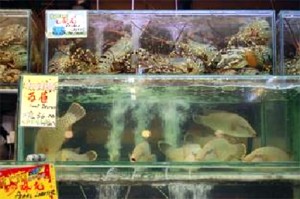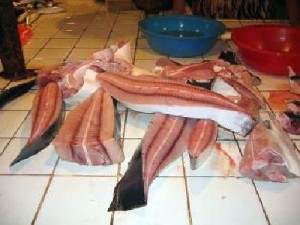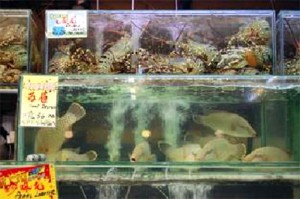By GREGORY PAUL H. YAN
(First of two parts)

INSIDE a dank, dimly lit corner shop within the sprawling Cartimar pet complex in Pasay City, a representative of the World Wide Fund for Nature (WWF) gazed at a large and brightly lit aquarium where the shop’s most expensive fish are displayed for sale.
His eyes veered toward a single occupant: A dull grayish-green fish delicately flecked with the darkest cyan diamonds, around the same size and build as a jumbo Tilapia, but with much thicker lips.
The day’s search was done. At last, a Mameng.
“Alam niyo po bang illegal iyan (Do you know that’s illegal)?” he asked a slight, mustachioed shop attendant cleaning a tank. Distracted, the attendant shot the WWF representative a quick glance, then shrugged.
Also called the Maori or Humphead Wrasse, the Mameng (Cheilinus undulatus) is one of the world’s most valuable live food fish, occasionally turning up in seafood restaurants, markets and even exotic pet retail centers like Cartimar. Fetching up to P6,000 a kilo in the posh seafood restaurants of Hong Kong, Singapore, Taiwan and Malaysia, the fish is certainly tasty—but endangered.
How traders are able to sell this, plus other endangered and legally protected marine organisms with impunity, is the story of the laxity of the Philippine National Police, Coast Guard, Bureau of Fisheries and Aquatic Resources and the Department of the Environment and Natural Resources in enforcing standing laws and curbing the illegal trade in marine life.
Following the Mameng trail
Among the world’s most massive, colorful and long-lived reef fish, adult Mameng grow up to six feet from snout to tail and can tip the scales at over 200 kilos. With a lifespan pegged at more than 30 years, Mameng are classified by the International Union for the Conservation of Nature (IUCN) as “endangered”— meaning wild populations may become extinct without immediate management and protection. Thus they are protected by Philippine law.
Republic Act 9147, or the Wildlife Resources Conservation and Protection Act, allows the collection of endangered or threatened wildlife solely for scientific, breeding or propagation purposes. It prohibits the killing of all endangered animals unless for religious or indigenous tribal rituals, if the animals host an incurable and communicable disease or unless the animals are killed in an act of self-defense. Thus the commercial trade in Mameng, whether for the seafood or aquarium trade, is punishable by law.
The Philippines became a signatory of the Convention on International Trade in Endangered Species of Wild Fauna and Flora (CITES) on Nov. 16, 1981. It is thus bound by an agreement to regulate the trade in all species, whether under Appendix I, II or III—a system that classifies species according to the immediacy of possible extinction.
Unless special permits are issued by a governing body such as the BFAR or the DENR’s Protected Areas and Wildlife Bureau (PAWB), all trade in endangered species, including consumption and sale, is prohibited.
In 2007, several high-profile Metro Manila restaurants, including Portico 1771 and North Park, were found to have been offering Mameng. With lobbying from WWF and concerned citizens, the dishes were promptly dropped from the menus.
Sadly, not all establishments have abolished the delectable fish from their rosters.
On a Saturday afternoon, hours before the typical influx of diners, the WWF representative visited the Seafood Restaurant Hotpot along Malate in old Manila and asked a trailing waiter, “Meron po ba kayong Mameng (Do you have Mameng)?”
“Meron po, pero mamaya pa makukuha, saka kukunin pa sa kabila (We have it, but we’ll get it later from the other restaurant),” he replied, referring to the restaurant’s extension.
Two weeks later, a separate trip to the Full Moon Restaurant and KTV Bar in Fort Ilocandia, Laoag, showed the dish was also on the menu. “We offer it mostly to the Chinese clientele,” said a waiter.
Illegal export of live and frozen specimens of Mameng has also proved lucrative. WWF data reveals that a meter-long Mameng fetched almost P60,000 in a single Hong Kong restaurant. The thick lips of the fish alone can sell for almost P20,000.
On the remote isles of Tawi-Tawi in southern Philippines, divers with compressors hunt for young Mameng in shallow reefs and drop-offs for several hours weekly. Once spotted and driven into cracks and crevices, the divers squirt a diluted mixture of sodium cyanide to stun and draw them out, inevitably killing all corals, sponges and other immobile invertebrates around the site. Once captured, the juvenile Mameng are reared in rudimentary, shallow pens made of corals and limestone.
These activities typically violate up to three laws. Not only is the capture of Mameng illegal, but intrusion and fishing in Marine Protected Areas (MPAs) plus cyanide use are also prohibited.
Captured fish are then fed and fattened for traders who come from the nearby Sabah (Malaysian) border. Traders from mainland China also come to buy the fish, which are then kept alive in aerated, filtered holds. In December 2006, 359 juvenile Mameng were confiscated from the M/V Hoi Wan, a Chinese fishing vessel apprehended in Palawan. The find remains one of the most significant wildlife apprehensions in Philippine history.
Though sufficient laws give authorities a legal basis to curb the trade, it continues—due chiefly to a lack of on-the-ground enforcement. There’s much more to the illegal seafood trade than just Mameng, though.
From giant sharks to giant clams
Sharks, manta and eagle rays, giant clams, even dolphins and whales are occasionally butchered and sold in various towns and cities throughout the country.

Off Bohol’s Pamilacan Isle in November 2006, WWF witnessed the butchery of Devil Rays (Manta mobula) and Manta Rays (Manta birostris), the latter being a protected species classified as “near threatened” by the IUCN.
Locally called Sanga, the majestic giants are usually caught after dark, their leisurely pace and tendency to surface making them easy prey for fishers armed with strobe lamps and drift nets. Dropped off in areas such as Baclayon Pier in Bohol, they are soon carted off for slaughter and sale, their tails cut off to make souvenirs.
Sanga meat fetches from P50 to P70 per kilo, depending on quality. Light meat is preferable and slightly more expensive. Dried Sanga strips fetch P500 to P800 per kilo. Deemed illegal by Fisheries Administrative Order 193 under Republic Act 8550 or the Fisheries Code of 1998, the trade in Manta Ray meat goes on.
“It’s really bad down in Masbate,” WWF Sorsogon researcher Dave David said during a research trip. “Fishermen hunt Manta Rays nonstop. It’s the wild west down there.”
Even the sea’s largest fish are not spared. On Feb. 15, 2010, an 18-foot long Whale Shark (Rhincodon typus) was found floating belly-up in Tingloy, Batangas. Dorsal and pectoral fins were neatly sliced off.
Long held in esteem as a Chinese delicacy, shark fins and meat are usually exported to China, Hong Kong and Taiwan. Whale Shark flesh, called “tofu meat,” sells for about P400 a kilo, while dried shark fins are valued a hundred times more—about P40,000 per kilogram.
BFAR disclosed that at least 200 of the sharks were slaughtered in 1997 alone. Stacked like cordwood, dried fins from a multitude of shark species are still seen today in Hong Kong shops.
Whale Sharks are classified by the IUCN as “vulnerable” and protected under Republic Act 8550 and Fisheries Administrative Order 193, the same law that protects Manta Rays. Possession or slaughter of a single Whale Shark merits a maximum jail term of four years, coupled with a maximum fine of P10,000 and the cancelation of the offending party’s fishing licenses.
Said WWF Conservation Programmes Head Joel Palma, “This is a real eye-opener, for it proves that the slaughter of endangered species—even one as big as a Butanding—can still take place if we let our guards down.”
Perhaps alarmingly, the Whale Shark remains the only legally protected shark in Philippine waters. But repeated visits to the Cartimar complex revealed white-tip and black-tip reef sharks, nurse sharks plus bamboo and epaulette catsharks—all sold legally, for P1,500 to P2,500 per shark.
An unnamed Chinese-run live seafood shop within the vast Dampa complex along Macapagal Highway also offers live nurse and bamboo catsharks for consumption, albeit at slightly more expensive rates.
Any visit to Cartimar, as well as other shops offering marine fish and invertebrates, will also likely turn up giant clams.
Seven of the world’s eight giant species can be found in the Philippines, all protected by RA 8550, which states that the taking of rare, threatened or endangered species as listed in CITES and as determined by the DENR, is unlawful. Violation of this section shall be punished by imprisonment ranging from 12 to 20 years, coupled with a fine of up to P120,000.
At yet another popular seaside palutuan in Mactan City in 2009, the WWF came upon seven live giant clams being sold for kinilaw, a popular dish.
Asked if she knew that selling the clams was illegal, the vendor smilingly replied, “Oo. Pero wala namang nanghuhuli eh (Yes, but no arrests are made).” Less than a hundred meters away lay a police outpost, perhaps too occupied to bother checking its environs.
A Cartimar vendor peddling giant clams said the police rarely raided her shop. “Saka hard corals lang ang kinukuha (They just confiscate the hard or reef-building corals).”
Whales and dolphins, too, are slaughtered and sold. In 2007, lobbying again convinced two upscale Makati restaurants, Tsukiji and Sushi Tsumura, to drop whale meat, an established Japanese delicacy, from their menus.
The list goes on, from endangered dugong to top-shells, Giant Triton and other shellfish. From city centers to remote markets, the trade in illegal marine life flourishes.
Read the conclusion, Sustainable seafood alternatives key to protecting dwindling marine species
(Gregory Paul H. Yan, a masteral student at the University of the Philippines College of Mass Communication and a Communications Officer for the World Wide Fund for Nature-Philippines, wrote a longer version of this report for his Investigative Journalism class taught by VERA Files trustee Yvonne T. Chua.)
